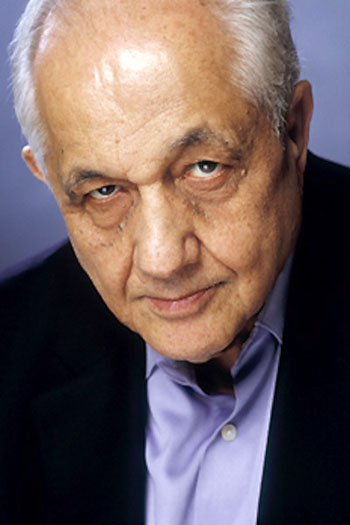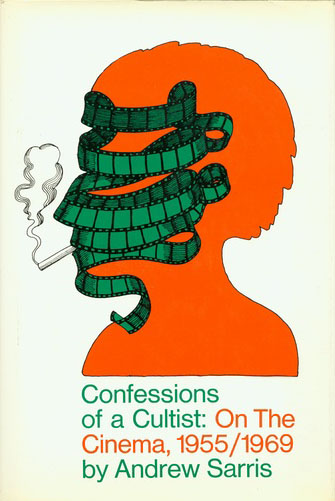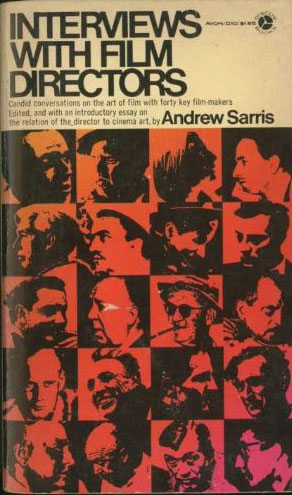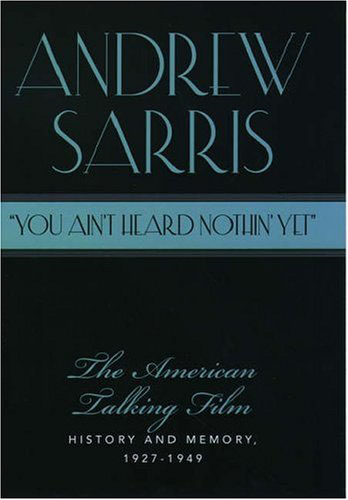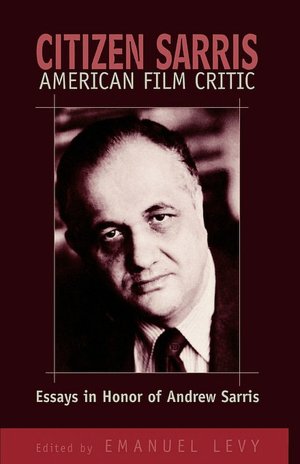“Andrew Sarris, one of the nation’s most influential film critics and a champion of auteur theory, which holds that a director’s voice is central to great filmmaking, died on Wednesday morning in Manhattan,” reports Michael Powell in the New York Times. “He was 83. His wife, the film critic Molly Haskell, said the cause was complications from a fall. Courtly, incisive and acerbic in equal measure, Mr. Sarris came of critical age in the 1960s as the first great wave of foreign films washed ashore in the United States. From his perch at The Village Voice, and later at The New York Observer, he wrote searchingly of that glorious deluge and the directors behind it—François Truffaut, Marcel Ophuls, Jean-Luc Godard, Michelangelo Antonioni, Ingmar Bergman and Akira Kurosawa.”
Powell profiled Sarris back in 2009: “His life in the 1960s was a blur of darkened screening rooms, celluloid epiphanies and running back to his desk to type with an eye on his competitors. What will Pauline Kael say? Or that snapping crab of a stylist, John Simon?… ‘We were so gloriously contentious, everyone bitching at everyone,’ said Andrew Sarris…, nattily attired in gray slacks and a blue sport jacket, his hair slicked back. ‘We all said some stupid things, but film seemed to matter so much.’ He peered up through his owlish eyes. ‘Urgency seemed unavoidable,’ he said.”
At They Shoot Pictures, Don’t They?, you’ll find a breakdown of Sarris’s director categories as laid out in The American Cinema: Directors and Directions 1929 – 1968. In 2005, Kent Jones wrote in Film Comment, “Every category contains a list of movie directors, and a corresponding sub-l Benefits ist of their films, the important ones are italicized, and the entire enterprise is appended by a series of hierarchical yearly lists, the top four or five films also bestowed with italics. This is an all-American affair. True, there is a smattering of foreigners (Fringe), and the one called Renoir was so great, it is said, that he made it into heaven (the Pantheon) with only five American films to his credit. But the particular spiritual discipline embodied in these revelatory lists and rankings is as deep dish-American as Emerson or Hawthorne…. It was Sarris who took it upon himself to overhaul American film criticism, by facing what everyone else had either avoided or backed into, with and without cultural alibis. And he accomplished it in a few rather simple, elegant moves. First of all, there was all that ranking, from most to least personal…. His smartest move was parachuting two French terms into the American critical language—Auteur and Mise-en-scène…. He gave me, and many, many others, a framework, a way of seeing and understanding an art form that was and still is culturally disreputable. I owe him a lot, and so does anyone else writing about cinema.”
Glenn Kenny: “The only thing in my mind right now is what Jean-Luc Godard said of Orson Welles: ‘All of us will always owe him everything.'”
Last year, the Browser asked Sarris to recommend five books of film criticism and, before he did, he commented: “I disagree with those who say film criticism is in crisis. There might be fewer people looking for a fight; it might be less polemical than it was when subscribing to a certain film theory could make you a marked man among your fellow critics. But I think as long as filmmakers keep making great work… the work will resonate and we will continue to wrestle with it. As a professor of film, I find that my students appreciate their predecessors and have greater access to good writing on film than people of previous generations.”
And here are Sarris’s top ten lists for the years between 1958 and 2005.
Updates: “When I was growing up in Manhattan,” recalls Anne Thompson, “feeding on movies at the Thalia, New Yorker and Elgin and working at the Bleecker Street Cinema during my stint at NYU Cinema Studies, Andy and Molly were the gracious and generous first couple of cinema, looked up to and admired. No one, not New Yorker critic Pauline Kael, not anyone, has done more to change the way we watch, interpret and think about movies, than Andrew Sarris.”
Carrie Rickey remembers her “colleague at the Village Voice, irascible, puckish and often querulous. But never haughty. I once ended an argument with him by telling Andrew he wasn’t condescending enough to pull off a certain gesture, that he was ‘an auteur sans hauteur.’ Thrilled to hear his gruff laugh! I did not always agree with him, but I always learned from him there, too. My heart goes out to his wife and personal goddess, Molly Haskell. I will honor him by watching Max Ophuls’s The Earrings of Madame de….”
Last year, Farran Nehme had tea with Sarris and Molly Haskell. “It was a beautiful afternoon, of which I will tell one thing only: At one point, I mentioned John Ford. I will cherish my memory of the way Sarris’s face lit up at the very sound of that name for the rest of my life.” And she selects a favorite quote from a piece Sarris wrote for the Partisan Review in 1972.
Kim Morgan tumbls a paragraph by Sarris on Josef von Sternberg.
“Sarris wrote a heartfelt but not sentimental remembrance of his great nemesis Kael when she died in 2001,” notes Richard Lawson at the Atlantic Wire. The Boston Phoenix‘s Peter Keough: “His cerebral and systematic approach to films contrasted with her spontaneous, subjective, and stylized methodology, and the conflict showed—just take a look at Gerald Peary‘s documentary For the Love of Movies.”
“It’s almost impossible, at this point in the 21st century, to imagine the world in which the feud between Sarris… and Kael… had so much resonance for so many people,” writes Salon‘s Andrew O’Hehir. “In a sense, they were both victorious. Kael’s personal, emotional, deceptively casual direct address, and her focus on sensual or visceral pleasure, has become the basis for nearly all published movie criticism, and a lot of other things besides…. Sarris’ baby… —the idea that the director is the true author of a motion picture, and the one person who can lend it artistic unity—is now a bedrock assumption in almost all discussions about movies, even in the case of studio-produced mass entertainments where it’s clearly not adequate. On the other hand, Kael and Sarris both lived long enough to repent of previous dogmas, and to see movies and movie criticism (as they understood those things) swamped by a tsunami of cultural and technological change. Shortly before her death in 2001, Kael reportedly told a friend, ‘When we championed trash culture, we had no idea it would become the only culture.’ Sarris suffered the indignity of being laid off by the New York Observer three years ago, during the great collapse of print media, and told a New York Times reporter at the time that his pugnacious earlier self had been ‘a solipsist and a narcissist and much too arrogant’ (almost exactly the terms Kael might have selected, way back when).”
“There’s no overstating Sarris’s impact on film criticism and scholarship,” writes Scott Tobias at the AV Club. “Inspired by the critics/filmmakers writing in Cahiers du Cinéma—a magazine he later helped translate into English—Sarris wrote the 1962 essay ‘Notes on the Auteur Theory,’ which imported the then-radical/now-commonplace notion of the director as the author of the film, with a stamp every bit as distinctive (in its best instances, anyway) as the writer of a novel…. Though some of his dismissals earned him some blowback—Billy Wilder, Stanley Kubrick, and John Huston rank low in the pantheon, for example—the theory exalted the work of filmmakers like Alfred Hitchcock, who at the time was considered more as a commercial craftsman than a genuine artist. In his first and most famous review for The Village Voice—where he wrote for 28 years—Sarris hailed Hitchcock as ‘the most daring avant-garde filmmaker in America today.’ Sarris was flooded with angry letters, according to this retrospective piece by the Voice‘s J. Hoberman, but time has surely vindicated him.”
IndieWIRE‘s Eric Kohn: “This critic counts himself among those chiefly inspired by the auteur theory in general and The American Cinema in particular to launch his own attempts at engaging with movies through the written word. As a participant in the Museum of the Moving Image’s 2008 workshop for film criticism and feature writing, I joined a few other participants for the brief opportunity to discuss the nature of the critical practice with Sarris and Haskell followed by an intimate dinner in which the couple laughed off our naive romanticizing of the New York film critic scene during the early years of their careers. Longer than any other critic of his generation, Sarris held tightly to his enthusiasm for the medium and never lost his luster for writing about it. Equally wise and down to earth, he embodied the idea that criticism was a way of life and the ideal means of formalizing one’s relationship to art. His dedication inspired generations and seems destined to continue its influence for years to come.”
The Guardian‘s Catherine Shoard plucks a quote from Powell’s 2009 profile: “Martin Scorsese, who once shared an office with Sarris, applauded his open-mindedness in a 2009 interview. ‘We were cowed into thinking that only European cinema mattered. What Andrew showed us is that art was all around us, and that our tradition, too, had much to offer; he was our guide to the world of cinema.'”
Following a summary of the debates over auteurism, the New Yorker‘s Richard Brody argues that Sarris, as opposed to Kael, “was resolutely independent. His following came not from the cultivation of a club or a clan but from the allure of the ideas he put forth. He didn’t embody the spirit of youth at the Village Voice, where he wrote for decades—rather, he inspired it, propelling generations of filmmakers and critics to go behind the screen, practically or virtually, in ways of their own. Whether he’s read or not, he’s the dominant figure of film criticism in the last half century. Like a director, he is present, exercising his influence, unseen, on a vast array of movie people and leaving a virtual impression on screens everywhere, from art houses to multiplexes.”
“Sarris often attacked more impressionistic and descriptive writing on film, although his work was more entertaining for the debates he routinely held with himself,” writes New York‘s David Edelstein. “Accused in the last three decades of resting on his status and quoting himself instead of doing fresh thinking, he was actually forever adjusting his judgments, shifting directors in and out of favor as he re-watched and rethought their work. What anchored his criticism—what made him rewarding to read even when you vigorously disagreed—was that he viewed The American Cinema as a work in progress.”
For Lisa Schwarzbaum, “as the content and language of movies morphs into a welter of sensations, and thumb-based (or even EW-style letter-grade based) assessment has become commonplace, the measured, observant, compassionate close study Andrew Sarris brought to the medium he loved so much is all the more valuable. It’s no secret that in a Kael-vs-Sarris world, my head is with the Sarrisites.”
“One did not so much read American Cinema cover to cover as bit by bit, consulting and digesting the sections on particular directors when appropriate,” recalls the Los Angeles Times‘ Kenneth Turan. “For years afterward, for instance, after making the extended acquaintance of a particular filmmaker’s work, I’d reach for American Cinema and see how my thoughts about it compared with Sarris’s. Invariably I’d be impressed by how well he’d extracted each filmmaker’s essence.”
“I was honored to meet Sarris on just a few occasions, most memorably during a panel discussion at the 1989 Sarasota French Film Festival,” recalls Joe Leydon. “I asked Sarris, politely but eagerly, when he might be writing a sequel to his masterwork. Sarris smiled warmly—as I’m sure he smiled the zillion or so other times some acolyte posed the same question—and offered a vague promise of ‘considering’ the idea. Truth to tell, though, I always suspected that, like most film critics, he had a natural-born aversion to sequels.”
“I was lucky enough to attend his film history class at Columbia University two years in a row, the first year for credit, the second year just to rewatch the films he showed and to hear him lecture.” At Bright Lights After Dark, C. Jerry Kutner lists the films he remembers seeing.
“If it were possible to wear the grooves out of a book as one can a record, I would have done so with the Preston Sturges chapter in his 1998 book ‘You Ain’t Heard Nothin’ Yet’: The American Talking Film, History and Memory, 1927-1949,” writes Mike at chained and perfumed, pointing us to the Pinewood Dialogue at Moving Image Source in which, in 2008, Sarris and Haskell spoke to a group of aspiring critics.
Ray Pride has a bit of viewing for us (“The Critic,” 28’26”): “Mr. Sarris appears about 15 minutes in, after the smirking obloquy of Mr. Simon.”
Updates, 6/21: Catherine Grant is gathering an invaluable set of links to essays on (and by) Sarris and auteurism.
Stephanie Zacharek for Movieline: “As I’ve said elsewhere, criticism isn’t about consensus—what’s most valuable is a critic’s ability to open your eyes, to make you see things that wouldn’t have occurred to you otherwise. The challenge isn’t just part of the bargain—it’s the whole bargain. And especially as we move further into an era of critic-proof big-budget movies—abetted by newspapers and other publications that happily repackage studio hype even as they’ve decided that professional critics are relics—Sarris’s contributions to the tradition and craft of film criticism have come to seem even more precious. In fact, they’re immeasurable.”
Tom Shone for the Guardian: “If Kael was the great prose stylist of American film criticism, the fierce anti-snob, beguiling readers by sheer force of her own reactions, caught dazzlingly on the hoof, Sarris was a more stately, slower-moving creature, gate-keeper of the Academy, the last of the high brows, the guy you went to for a legitimacy polish.”
“He is frequently misunderstood by his critics, not least by Pauline Kael,” writes Fredrik Gustafsson. “He did not disregard other contributors such as screenwriters, neither did he disregard the context. His views on cinema were suitably complex and evolving later changed his mind about Wilder, and moved him up to the top of the pedestal, and about ‘auteur theory’ he said that it was ‘not so much a theory as an attitude.’ I never really understood why it was even called a theory, unless for polemical reasons. And polemical he was.”
Press Play gathers tributes from Aaron Aradillas, Miriam Bale, Steven Boone, Godfrey Cheshire, James Grissom, Margaret Hames, Kevin B. Lee, Craig D. Lindsey, Matt Zoller Seitz, and Max Winter as well as a video in which Sarris talks about Curtis Hanson’s L.A. Confidential (1997) (1’44”).
“A few years ago, we had a project we called ‘Clip Job’ whose aim was to get onto the web some of the Voice‘s best material from its pre-Internet archives. Naturally, Sarris’s column was often one we chose to republish.” Editor Tony Ortega presents nine of the best.
The American Cinema “was a bible for countless cinephiles, including me,” writes J. Hoberman at Artinfo. “My undergraduate comrades and I used to call it The Book, as in ‘Paul Wendkos? I don’t know—check the book!’ I referred to my tattered, underlined copy so often as to have whole chunks engraved in my memory: “What burst of Buddhist contemplation was responsible for such a haunting exception to such an unexceptional career?’ I knew Andy for over a decade as a colleague at the Voice. He was a vivid character, a big guy with deep-set, raccoon-ringed eyes (too many movies?), an instantly recognizable hearty laugh and a roguish sense of humor. We had our critical differences, and even a few battles, over the years, but I never doubted—or was less than inspired by—his devotion to the two media we shared, movies and newspapers.”
“The best memorial tribute I could pay to Sarris,” blogs James Wolcott, “is to encourage readers to download Love & Other Infectious Diseases by his wife, fellow critic, and now widow Molly Haskell, a memoir about the near-death spiral Andy suffered in the late 1990s after an encephalitic viral infection that is unsparing in its undignified details of what happens to the body under siege–and a mind that temporarily loses its moorings–yet never maudlin or melodramatic (a Greer Garson-Irene Dunne poise particularly impressive since Haskell’s health also took a serious dive during her husband’s illness). Perhaps it’s the unfortunate title, but Love & Other Infectious Diseases has never gotten its rightful attention and I have the impression, based on my wandering around the apartment, that even film bloggers are largely unaware of it, much as they appear to be unaware of anything that isn’t coming out eventually on Blu-Ray. No matter. Love & Other Infectious Diseases can be bought as a Kindle ebook, and is, at $3.99, an unimpeachable bargain.”
Time‘s Richard Corliss, who ran “Notes on the Auteur Theory in 1970” when he was editor of Film Comment, writes a remarkable mini-biography of Sarris and then turns to Haskell: “Andrew was not exactly Spencer Tracy…. But this Greek Spencer found his Hepburn—as much Audrey as Katharine—in Molly. Gifted, gorgeous, chic as Chanel, Molly also had that Sarrisish sand-in-the-oyster feeling of an outsider at the marvelous party to which her celebrity had made her an honored guest…. What Andrew wrote of Mankiewicz in The American Cinema, that ‘his vibrant women … shine with special brilliance from midnight to the three o’clock in the morning of the soul,’ might be meant as a paean to his own vibrant woman. Street kid and penthouse lady, the Sarris-Haskells were the couple of the year—any year from 1969 till today, and forever. Rest in peace, Andrew. Live long and be strong, Molly.”
“I admired Sarris not just for his many brilliant perceptions into directorial (and performative) style, but also for his economy,” writes Bilge Ebiri. “For another project I recently had to revisit his entry on Fritz Lang in The American Cinema, and was stunned by how much insight he packed into such a brief essay; I got more out of those two pages than out of the acres of biographies and monographs and critical navelgazers I’d read on Lang previously. Sarris could put the most complex and grand thoughts into the briefest sentences, while also essentially forcing you to think beyond the page. Here’s how he ends the Lang entry: ‘Lang might argue that in a century that has spawned Hitler and Hiroshima, no artist can be called paranoiac; he is being prosecuted.’ Go out into the night with that thought in your head, why don’t you.”
“In December of 1967, my first year as a film critic, I read every word of Sarris’s Interviews with Film Directors, which singled out those he found noteworthy,” recalls Roger Ebert. “I underlined Sarris’s observation: ‘Even art films have to make money and even commercial films have to make some statement. To put it another way, more and more critics are demanding that there should be more fun in art, and more art in fun…. In the process… it has become possible to speak of Alfred Hitchcock and Michelangelo Antonioni in the same breath and with the same critical terminology.’ This, to me, was a signpost pointing the direction that a daily newspaper film critic might choose.”
“Sarris served alongside the late Amos Vogel on the [New York Film Festival’s] very first selection committee (beginning in the festival’s fourth year),” notes the Film Society of Lincoln Center’s Scott Foundas. “And he wrote about them with a clarity, economy, insight and deadpan wit—an ability to seem at once inside and outside of a film, decoding its patterns while placing it in broader artistic and sociological contexts—that remains all too rare in criticism today. It was a way of looking at cinema that lived on at the Voice long after Sarris had moved on from the paper, chiefly in the person of his learned successor, J. Hoberman. All of which is to say that I find it unfortunate that so much writing about Sarris over the years reduced the critic and his work to misinterpretations of his writings on the ‘auteur theory,’ and hoary old clichés about his ‘feud’ with New Yorker critic Pauline Kael.”
“Reading the accounts and appreciations of him today,” writes Jim Emerson in a similar vein, “I was surprised to see how many people perpetuated the myth that Sarris and Pauline Kael were like the print era’s Siskel & Ebert who, instead of facing off with each other over new movies on TV week after week, carried on a robust public debate about auteurism and film theory for decades. That didn’t happen.” As Jim Emerson lays it out, Sarris published “Notes on the Auteur Theory” and Kael responded with “Circles and Squares: Joys and Sarris,” “and thereafter Sarris panned her first collection, I Lost it at the Movies. (He also dismantled her slipshod ‘Raising Kane’ essay in 1971, as did many others.) There was no lengthy, ongoing public debate or exchange of ideas between Sarris and Kael themselves from then on. So, the false nostalgia for the great days of ‘Kael vs. Sarris’ is baffling.”
Listening (7’15”). Fresh Air posts an interview Terry Gross conducted with Sarris in 1990.
Updates, 6/22: Kent Jones has invited Geoffrey O’Brien, Glenn Kenny, Robert Horton, and Phillip Lopate to contribute remembrances to Film Comment, and he opens the collection himself by looking back on his tattered copy of The American Cinema: “And as I followed Andrew’s writing in The Village Voice over the years, I came to understand all the rankings and hierarchies not as edicts but as invitations to exploration. Andrew and Manny Farber occupied separate planets as human beings and as writers, but one quality they shared was an acknowledgment of the provisional nature of all judgments. Andrew was always re-thinking the categories, revising

